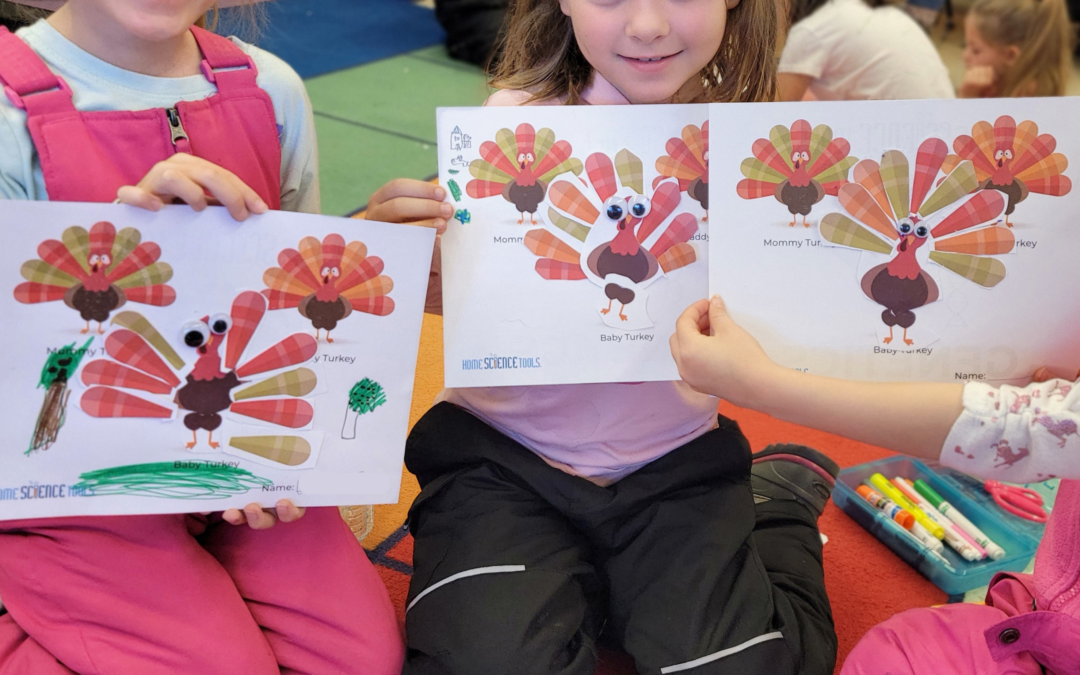Science Questions: Explaining the Universe to Kids
“Why is the sky blue?”
“Why can I sometimes see the moon during the day?”
“Why do birds fly south in the winter?”
Kids have so many science questions! Delight their curiosity with these answers to top science questions kids ask.
These simple answers are easy to understand, but tackle real science concepts to answer the how and why of our world.
 1. Why is the sky blue?
1. Why is the sky blue?
The earth is surrounded by an atmosphere.
The atmosphere (i.e., air, one of the four elements) is a mixture of gasses, mostly nitrogen and oxygen.
The way the sun’s light travels through the atmosphere makes the sky look blue.
White light is made of several different colors, like you see in a rainbow. Each of these colors travel in a wave, but the wavelength (distance between the tops of each wave) varies. Red light has a long wavelength, while blue light has a much shorter wavelength.
 When light from the sun enters our atmosphere, the waves collide with gas molecules. The longer wavelengths, like red and yellow, pass straight through and appear to us as “regular” sunlight.
When light from the sun enters our atmosphere, the waves collide with gas molecules. The longer wavelengths, like red and yellow, pass straight through and appear to us as “regular” sunlight.
Shorter wavelengths, like blue, bump into the gas molecules and scatter in different directions. Some of it still makes it through directly, but the rest is reflected back to our eyes from all directions, so the whole sky looks blue.
Use a slinky to demonstrate wave-length motion.
2. How much does the earth weigh?
The earth weighs 13,170,000,000,000,000,000,000,000 pounds. You can say this number like this: 13 octillion, 170 septillion. That’s A LOT more than a million, billion, or trillion pounds!
To put things in perspective:
- One male African bush elephant weighs 13,000 pounds.
- 100 elephants would weigh 1,300,000 (one million, 300 thousand) pounds.
- One million elephants would weigh 13,000,000,000 (13 trillion) pounds.
- One trillion elephants–there are not even this many on earth–would weigh 13,000,000,000,000,000 (13 quintillion) pounds.
And still, earth weighs one billion times more than that!
How do scientists know how much the earth weighs? They study the gravitational pull the earth has on other objects, and use math to calculate how big the earth must be.
Hold the “world” in your hands with a crosssection of earth.
 3. How far away is the sun?
3. How far away is the sun?
The sun is 93 million miles away from the earth. Even light, which travels so quickly that we cannot even see it move, takes eight minutes to get from the sun to earth.
In a jet traveling 550 miles per hour, it would still take 19 years to reach the sun. In a car traveling 60 mph, it would take about 177 years.
This is one of those science questions that boggle even the adult mind!
Using the power of the sun, explore your creativity with a sun print paper kit for kids and adults.
4. What is a black hole?
A black hole is an area in space where matter (what everything is made of) has collapsed in on itself.
This means a lot of matter takes up only a tiny amount of space.
A black hole has a strong gravitational pull that sucks in everything nearby – even light. Nothing can escape it.
Should you be worried that a black hole will suck up the earth and the rest of our solar system? Definitely not.
Many galaxies have black holes in them. A black hole is large enough to pull objects near it, but not those far away.
Even supermassive black holes will not continue to grow forever. Just as the black hole was born, it will one day die. A black hole will slowly evaporate, releasing the energy it took back into space.
Study the stars with an Orion reflector telescope.
 5. How do airplanes fly?
5. How do airplanes fly?
Even though airplanes are very heavy, they stay up in the sky.
Why is this?
There are different forces (pushes and pulls) that make flight possible.
Lift is caused by the variation in air pressure when air flows under and over an airplane’s wings. This force lifts up. It is opposed by weight, or the force of gravity, pulling downward.
Thrust is caused by the action of the propellers moving the plane forward. Opposed to that is drag, caused by air resistance. If lift is more than weight, the plane will rise. If thrust is more than drag, the plane will gain speed.
Airplane wings are designed to take advantage of lift. They are shaped so that air has to travel farther over the top of the wing than underneath it.
When the air has to travel farther over the top of the airplane wing, it must also travel faster, which results in lower pressure. The shorter distance under the wings results in higher pressure, causing the airplane to move upward.
Explore the physics of flight by building a model airplane with the ultralight glider kit.
6. How do flies walk on the ceiling?
Flies can walk upside down! They can do this because of their sticky feet.
A fly has foot pads that are covered in tacky glue.
To unstick their feet so they can walk anywhere, the fly uses tiny foot claws to push or twist themselves away.
Explore glues and polymers with a slime science kit for kids.
 7. How are rainbows made?
7. How are rainbows made?
A rainbow is formed when light hits water droplets in the air and is refracted, or bent.
Light that appears white (like light from the sun) is actually made up of several colors!
The colors that make up white light are the same colors that make a rainbow. They are: red, orange, yellow, green, blue, indigo, and violet.
You can often see a rainbow after it rains. Beams of sunlight shine towards the rain in the air and when the light goes into the raindrops, it is bent (refracted).
When the light bends, it breaks into all of its colors. Each color leaves the raindrop at its own angle, different from all the others.
The colors of the rainbow always appear in the same order because each color always bends at the same angle.
Learn more about colors, make your own simple rainbow, and make a prism with these sunny day activities: 3 Rainbow Science Projects.
Bend and refract light with a glass prism. Perfect for hours of fun!
8. Are sharks mammals?
Mammals, like polar bears, squirrels, lions, elephants, and dolphins, give birth to live young. They are warm-blooded, and have fur or hair.
Sharks are a type of fish. They use gills to breathe. They also do not have bones like we do, but have a skeleton made of cartilage (the same flexible material at the end of your nose).
Another interesting thing about sharks is that some are oviparous (they lay eggs), while others give birth to live young.
Study shark anatomy with a dogfish shark dissection.
 9. Why can I see the moon during the day?
9. Why can I see the moon during the day?
The moon is the brightest object in the night sky. During the day, the sun is much brighter! But sometimes, you can see the moon during the daytime. Why is this?
The moon is always in the sky. It orbits (travels in a circle) around the earth.
The moon looks bright at night because of light from the sun reflecting off the moon’s surface. The sun always lights up half of the moon. But we cannot always see that part of the moon – sometimes it is facing away from us.
During the day, we can see the moon if it’s a clear day, and the moon is not hiding low in the sky.
The moon is also easier to see when its orbit brings it closer to earth.
Sometimes we see a full moon, big and round. Other times we see only part of the moon (a crescent). Learn more about the phases of the moon!
Look for the moon in the sky today! If the moon is waning (appearing smaller each night) look for it in the morning, after sunrise.
If the moon is waxing (appearing bigger each night) look for it in the late afternoon or evening, before sunset.
You can’t see the moon during the day if it is a full moon (big and bright) or a new moon (you don’t see any light).
Track the phases of the moon with weather forecast station
 10. Why do birds fly south for the winter?
10. Why do birds fly south for the winter?
Many birds fly south in the winter. Birds that eat nectar or insects will not be able to find food in areas that have cold winters.
To find the food they need, birds will migrate.
Migrating means leaving to find warmer areas.
Birds that migrate usually leave at about the same time each year and fly back home at around the same time each spring!
How do they know when to come back to their homes? Well, that is something we don’t know for sure, but birds (like most other animals) have strong instincts that tell them when it’s warm enough to head back to their homes up north.
When birds migrate, they fly in large groups or flocks and they often fly in the shape of the letter “v,” which helps them glide along on the currents in the air so they don’t have to work as hard!
Some kinds of birds might fly very long distances, like from Canada down to Central America, while other kinds of birds only fly across a few states.
It can take the flocks weeks or even months to get to their winter home in the south, depending on how far they have to go and how fast they fly.
Explore the world of bird-watching with a golden guide birds book and Celestron 10 x 50 binoculars.
More Kid-Friendly Science Questions:
Browse some of our top-selling science kits for kids of all ages. Explore force and motion with a physics lab experiment, make a DIY battery with our potato battery kit, study alternative energy with a solar power experiment, learn about acids-base reactions with a bath bomb science kit, observe the microscopic world around you with a home microscope, and explore your backyard with rockhound kits.





